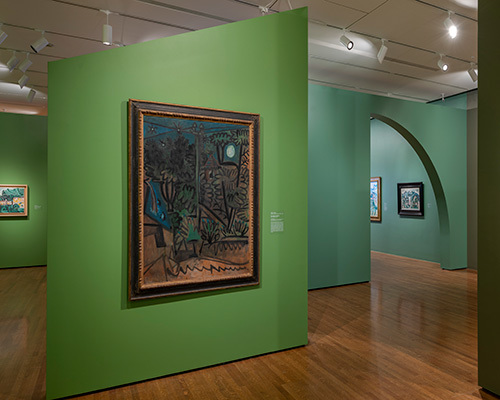Vallauris & Cannes
Hello, I am Emily Holtrop, the museum’s director of learning & interpretation. I will be reading an introduction to the “Vallauris and Cannes” section of Picasso Landscapes: Out of Bounds.
Picasso made his first trip to Vallauris in Provence (southeastern France) in 1948. Within a year he returned to the seaside village to purchase Le Fournas, a former perfume distillery, where he set up his studio. Though he maintained a peripatetic lifestyle, traveling extensively across France and Europe, Picasso was based in Vallauris for seven years (1948−1955), painting the bucolic village throughout that period. The paintings and magazine to the left date from this period. In the course of tracing his career, the documentary film screening nearby brings us face to face with the seventy-two-year-old Picasso in his studio at La Fournas.
In May 1955, Picasso moved to the Villa La Californie, a few miles southwest of Vallauris, overlooking the hills of Cannes. The three small paintings to the right—swift, confident explorations of form, atmosphere and technique—were made there.

Pablo Picasso (Spanish, active in France, 1881–1973), Moonlight At Vallauris, Vallauris, September 1951, oil on plywood, Smith College Museum of Art, Northampton, MA, Gift of Mrs. Werner E. Josten, SC1974.41 © 2023 Estate of Pablo Picasso / Artists Rights Society, (ARS), New York, Courtesy American Federation of Arts
Verbal Description
Hello, I am Emily Holtrop, the museum’s director of learning & interpretation. I will be reading a description of the painting Moonlight At Vallauris in Picasso Landscapes: Out of Bounds.
Pablo Picasso, a Spanish artist who lived from 1881 to 1973, painted Moonlight At Vallauris in oil on plywood in September 1951. Mrs. Werner E. Josten gave it to the Smith College Museum of Art in Northampton, Massachusetts, where its reference number is SC1974.41.
Moonlight at Vallauris is a large vertically oriented painting measuring 53 and seven-eighths by 41 and one-quarter inches or 136.8 by 104.8 centimeters. In this night scene, a full moon in the upper right corner of the picture illuminates the included elements. The sky is dark blue with what may be a few stars in the upper left. In the center of the image is a black electrical pole with power lines stretching to the right and left and off the side of the canvas. Green trees and foliage outlined in black populate the space around this central poll. A structure that could be a bell tower peaks out behind the trees. In the foreground and along the painting’s right side, the palette shifts from deep blues and greens to light browns and tan; this perhaps indicates an off-canvas light source.
Label Text
Hello, I am Emily Holtrop, the museum’s director of learning & interpretation. I will be reading the label for the painting Moonlight At Vallauris in Picasso Landscapes: Out of Bounds.
Pablo Picasso, a Spanish artist who lived from 1881 to 1973, painted Moonlight At Vallauris in oil on plywood in September 1951. Mrs. Werner E. Josten gave it to the Smith College Museum of Art in Northampton, Massachusetts, where its reference number is SC1974.41.
While Picasso regularly painted the land on and around his expansive property in Vallauris, he rarely did so at night. Moonlight at Vallauris conveys the mystery endowed upon the familiar buildings, trees, telephone poles, and bushes when lit only by a low, hazy moon in a midnight sky. This painting also reflects Picasso’s admiration, which persisted from the 1950s through the 1960s, for the Dutch painter Vincent van Gogh, who devoted many canvases to nocturnal views of the countryside in Provence, including his famed Starry Night of 1889.
